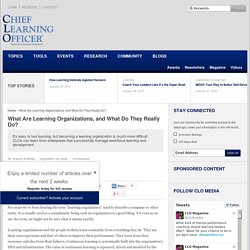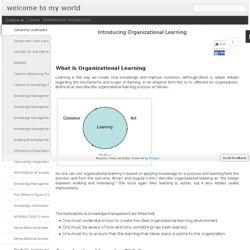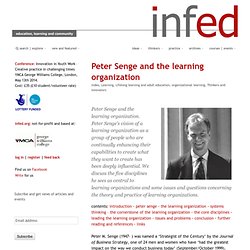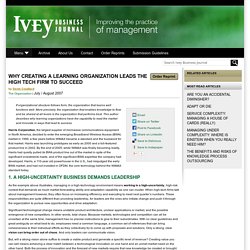

Innovation Management Article Library. Leading Strategic Innovation in Organizations. What are learning organizations? For years we've been hearing the term "learning organization" used to describe a company or other entity.

It is usually used as a compliment: being such an organization is a good thing. Yet even as we use the term, we might not be sure what it means exactly. Learning organizations and the people in them learn constantly from everything they do. They use their own experience and that of others to improve their performance.
They learn from their successes and also from their failures. In a true learning organization, communication is open and widespread, people at all levels are included in most communications and it's assumed everyone "needs to know. " Further, senior leaders demonstrate they are learning constantly by communicating what they are learning as they learn; people are rewarded for learning with recognition, growth jobs, promotions and even financial compensation, and people who don't learn are managed out of the organization.
But to become one is not so easy. The 5 Disciplines of a Learning Organization. Introducing Organizational Learning. These views should be seen as complementary rather than contradictory.

The next two sub-sections will examine organizational learning theory from these two perspectives. Two of the most noteworthy contributors to the field of organizational learning theory have been Chris Argrys and Donald Schon.Organizational learning (OL), according to Argrys & Schon is a product of organizational inquiry.
This means that whenever expected outcome differs from actual outcome, an individual (or group) will engage in inquiry to understand and, if necessary, solve this inconsistency. Peter senge and the theory and practice of the learning organization. Contents: introduction · peter senge · the learning organization · systems thinking – the cornerstone of the learning organization · the core disciplines · leading the learning organization · issues and problems · conclusion · further reading and references · links Peter M.

Senge (1947- ) was named a ‘Strategist of the Century’ by the Journal of Business Strategy, one of 24 men and women who have ‘had the greatest impact on the way we conduct business today’ (September/October 1999). While he has studied how firms and organizations develop adaptive capabilities for many years at MIT (Massachusetts Institute of Technology), it was Peter Senge’s 1990 book The Fifth Discipline that brought him firmly into the limelight and popularized the concept of the ‘learning organization’. Since its publication, more than a million copies have been sold and in 1997, Harvard Business Review identified it as one of the seminal management books of the past 75 years. Peter Senge. Is Yours a Learning Organization? Leaders may think that getting their organizations to learn is only a matter of articulating a clear vision, giving employees the right incentives, and providing lots of training.

This assumption is not merely flawed—it’s risky in the face of intensifying competition, advances in technology, and shifts in customer preferences. Organizations need to learn more than ever as they confront these mounting forces. Each company must become a learning organization. The concept is not a new one. It flourished in the 1990s, stimulated by Peter M. Unpredictability is very much still with us. In this article, we address these deficiencies by presenting a comprehensive, concrete survey instrument for assessing learning within an organization.
Why creating a learning organization leads to business success. If organizational structure follows form, the organization that learns well functions well.

More precisely, the organization that enables knowledge to flow and be shared at all levels is the organization that performs best. This author describes why learning organizations have the capability to read the market and innovate in ways that lead to success. Harris Corporation, the largest supplier of microwave communications equipment in North America, decided to enter the emerging Broadband Wireless Access (BWA) market in 1999, a few years before WiMAX became a standard and the buzzword for that market.
Harris was launching prototypes as early as 2000 and a full-featured product line in 2002. By the end of 2005, while WiMAX was finally becoming reality, Harris had quietly pulled its BWA product line out of the market in spite of the significant investments made, and of the significant BWA expertise the company had developed. 1. 2. 3. It’s not about making decisions. 4. 5. 6. ROLE Survey - Assessing organization readiness to learn. Building the Learning Organization. Tools for building a learning organization. Building A Learning Organization - PDF Version (1.08 MB)* Table of Contents Foreword As Champion of the National Managers' Community, I am proud to present the third edition of Tools for Leadership and Learning.

This publication represents various tools and practices that are being used by managers and practitioners throughout the public service. They help us to build our capacity to understand and master the changing roles that come with a knowledge-based economy and society. To me, the most exciting thing about this publication is how it illustrates that the public service is an organization in which we learn from each other, sharing tools and techniques to build a work environment that values personal initiative, innovation, team playing, learning and trust.
The fact that we are printing a third edition, demonstrates that it has been a really valuable resource for public service renewal over the past few years. Michael G. Author’s Acknowledgements Introduction.